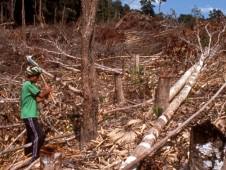
The threats leading to population declines in birds are many and varied: agriculture, logging and invasive species are currently the most severe threats, respectively affecting 1,096 (74%), 735 (50%) and 566 (38%) globally threatened species. These threats create stresses on bird populations in a range of ways, the most common being habitat degradation and conversion, which affect 1,398 (94%) and 1,213 (82%) threatened species respectively.

There are a number of ongoing threatening processes driving declines in bird populations. Foremost among them are the spread of agriculture which puts 1,096 threatened birds (74%) at risk, logging and wood harvesting impacting 735 species (50%) and invasive species which threaten 566 (38%) threatened species (BirdLife International 2020). In addition, hunting and trapping, climate change, and residential and commercial development are having serious negative impacts (see figure). While all of these threats have additive negative effects on species, climate change in particular often exacerbates other threats. All threats are taken into account in the IUCN Red List assessments for each species and contribute to their classification as globally threatened (Critically Endangered, Endangered or Vulnerable). High-impact threats typically affect the majority of the population and cause rapid declines, while low-impact ones typically affect the minority and/or cause slower, albeit still significant, declines. These threatening process impact species’ populations in a number of ways (see figure). Habitat degradation and conversion (driven by anthropogenic activities such as logging and agricultural expansion) currently impact 1,398 (94%) and 1,213 (82%) of threatened birds respectively, while direct mortality and reduced reproductive success resulting from many of the processes listed above are affecting 57% and 34% of threatened species respectively (BirdLife International 2020).

When species populations become very small, even stochastic, unpredictable events such as natural disasters (e.g. volcanoes, cyclones, drought) or pressure from problematic native species (e.g. increased competition or hybridisation) may pose a high risk of extinction.
Many threats can be reversed given sufficient resources and political will, so targeted actions have been recommended for all threatened birds to directly address specific threats.
Related Case Studies in other sections
References
Compiled: 2004 Last updated: 2021
Recommended Citation:
BirdLife International (2021)
A range of threats drives declines in bird populations.
Downloaded from https://datazone.birdlife.org/sowb/casestudy/a-range-of-threats-drives-declines-in-bird-populations on 21/12/2024